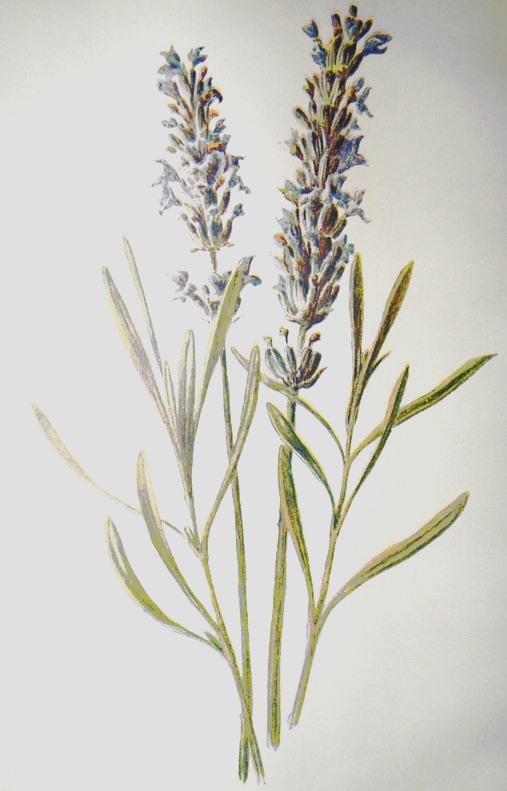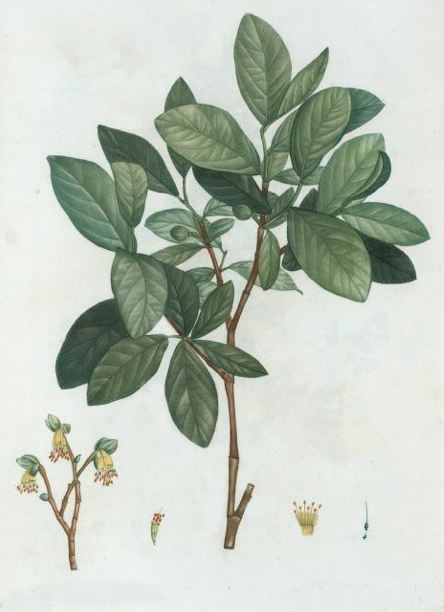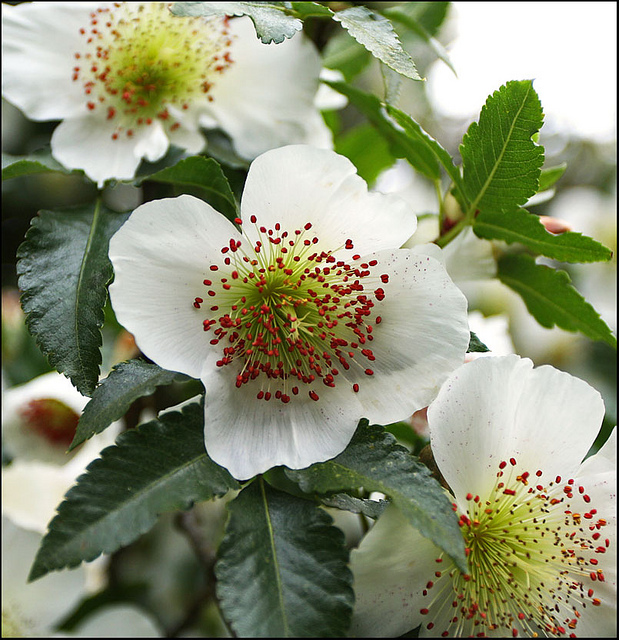la·bile (lā´bīl or lā´bil) adj. 1 subject to change or instability. 2 capable of movement; motile; vagile. [< LL lābilis < L lābī slide, slip] —la·bil´i·ty, n.
lady’s-mantle n. any of the species of genus Alchemilla L. (of the Rosaceae), spreading or erect perennial herbs bearing palmately-lobed or compound leaves and leaf-opposed terminal cymes of small yellowish flowers.
lam·i·nal (lam´ə nəl) adj. of or pertaining to a lamina or leaf blade. [< L lamina plate + -ālis pertaining to, similar to]
lam·i·nate (lam´ə nāt´) adj. 1 possessing an expanded portion of a leaf or petal – a blade. 2 possessing an elongate flat portion of a thallus, as in kelp. 3 conformed in other flat, sheet-like structures. [< L lamina plate + -ātus provided with]
Lammas leaves n.pl. with respect to some tree species growing in temperate habitats, a second crop of leaves produced in high summer, usually in response to heavy browsing by insects upon the first crop of leaves. Often they can be discerned from the first crop by minor physical differences. [< Lammas Day (August 1 in northern hemisphere, February 1 in southern hemisphere) < AS hlaf-mas loaf mass]
language of flowers n. a coded system of relaying messages based upon a combination of medieval love poetry and Christian symbolism, utilizing flowers as the cyphers.
lap·sus ca·la·mi (läp´süs kä´lä mē) n. lap·sus ca·la·mi. written error(s), often a mistaken citation of a species from a place outside of its actual range; a slip of the pen. [L lapsus slip, go wrong + calami reed, pen]
lat·er·al (lat´ər əl) adj. 1 of or pertaining to the side of an organ, or of an organism. 2 attached to the side of an organ. [ME < L lateralis < latus side, flank] —lat´er·al·ly, adv.
la·trorse (lat´rôrs´ or lā´trôrs´) adj. of anthers, rupturing and releasing their pollen laterally toward other stamens of the flower. [NL < L latus side, flank; on pattern of extrorsus outward] —la·trorse´ly, adv.
lau·ri·sil·va (lô´ri sil´və or lou´re sil´və) n. a category of subtropical forest occurring in many places, characterised by humidity and constant temperature through the year, and evergreen trees bearing lustrous elongate leaves, as those common in the Lauraceae family, although this family is not necessarily a component in each example of this biome. [< L laurus laurel + silva forest]
lau·ro·phyll (lou´re fil´) n. of leaves, those which share many characteristics of the leaves of laurel trees, including a lustrous adaxial lamina which is also elongate and evergreen, often bearing a thick waxy cuticle, and possessing a drip tip. [< L laurus laurel + Gk. phýllon φύλλον leaf]
lav·en·der (lav´ən dər) n. adj. v.t. —n. 1 a genus of low shrubs (Lavandula L., of the Lamiaceae), native to a variety of habitats in Europe, Africa, and the near East. It bears flowers with a pleasant scent, and has long been a stalwart of the perfumery and medicinal repertoire. 2 dried flowers and attached foliage of this plant, bundled to provide a pleasant scent to bedlinens, and to clothes. 3 a scented oil derived from flowers of this plant. 4 a pale blue-purple colour, suggested by the flowers. —adj. 1 of or pertaining to this plant. 2 of or pertaining to the pleasing scent which it produces. 3 of or pertaining to the colour of this plants’s flowers. —v.t. perfume with lavender. [ME < ONF lavendre < Med.L lavandula]
law of the minimum n. an ecological tendency for the growth of a species to be limited most by that resource present in the least amount. A corollary of this law is that the most intense competition is found between members of a single species, because they share the same requirements.
lay·er (lā´ər) n. v.t. —n. a branch which is fastened down to induce adventitious rooting while attached to the parent plant. —v.t. propagate a parent plant into additional clones as layers. [? < obsolete ME lair quality of soil]
Lazarus taxon n. (pl. taxa) a taxon which is known from fossil records, but which is absent from one or more subsequent periods and then reappears in later fossils or as a living representative. Two examples are the dawn redwood and the Wollemi pine. [< Aramaic אלעזר God is my help (a man of Bethany interred for 4 days whom Jesus of Nazareth called to life again)]
lead·er (lē´dər) n. an active shoot upon a plant, located at the apex or at the tip of a principal branch.
lead·wort (led´wôrt) n. any of a number of herbs and shrubs of the genera Plumbago L. and Ceratostigma Bunge (both of the Plumbaginaceae), bearing rotate pentamerous flowers which can be white, blue, or red. [Pliny the elder perhaps named the plant for the lead-coloured stain its sap can leave upon skin]
leath·er·wood (leŦH´ər wu̇d´) n. 1 a shrub or small tree native to southeast coastal North America (Cyrilla racemiflora L., of the Cyrillaceae), bearing striking white flowers. 2 a shrub also native to southeast North America (Dirca palustris L., of the Thymelaeaceae), which bears ephemeral flowers; wicopy. Other species of this genus may also be called leatherwood. 3 any of several species of the genus Eucryphia Cav. (of the Eucryphiaceae), trees native to the southern hemisphere, and especially those native to Australia or New Zealand. These bear conspicuous flowers notable as a source of nectar for bees.
lec·to·ty·pi·fi·ca·tion (lek´tō tip´ǝ fi kā´shǝn) n. the designation of a lectotype, where no holotype exists. [< Gk. lektos λεκτός chosen + typos τύπος an impression, image, type + L -ficātiōn a making (< -ficāre make, cause to be)]
leep (lēp) n. Brit.dial. a basket: The white haulm was drawn from the earth in like manner, and woven into corn-leeps. [< OE lēap basket]
leg. Abbrev. 1 used in scientific taxonomy preceding the collector for a specimen, and meaning ‘as identified by and conforming to the understanding of…’ 2 in scientific taxonomy: a a number of supposed related species or subspecies; legion. b Obs. a collection of taxa beneath classis but ranking above ordinis. [< L legiō (< legere read, choose) < Gk. λέγω gather, reckon]
let·tuce (let´is) n. a somewhat bitter leaf vegetable (Lactuca sativa L., of the Asteraceae), which was native from the Mediterranean Sea to Siberia. It commonly grows as a sessile apical whorl or head of young leaves, although many cultivars exist, and is now much-cultivated for use in salads. [ME < OF letues, laitues < L lactuca < lac, lactis milk (latex)]
leu·co·phyte (lū´kō fīt´) n. an alga which has become colourless and non-photosynthetic. Where known, this appears to be an irretrieveable change, leaving the plant to survive as a heterotroph. Affected cells retain structural features of their progenitors, except for the lack of chlorophyll. [NL < Gk. leukos λευκός white + phyton φυτόν plant]
li·ber (lī´bər) n. phloem. [< L liber tree bark]
Li·ber (lī´bər) n. in ancient Italian legend, the god of vineyards and wine.
lich·wale (lich´wãl) n. an herb native to temperate Eurasia (Lithospermum officinale L., of the Boraginaceae), bearing as fruit relatively large white nutlets; gromwell. Its nutlets have some reputed medicinal use as a diuretic. [< ME lichewal, ? < OE līc body, corpse, form + Scot. wal, wale selected, best]
lich·wort (lich´wôrt) n. an herb native from southern Europe eastwards (Parietaria officinalis L., of the Urticaceae), bearing whorls of small flowers at its nodes, and often found growing against a wall; pellitory². [< ME lychewort, licheuart < OE līc body, corpse, form + wyrt plant]
lic·o·rice (lik´ə rish) n. US. liquorice.
life·form (līf´fôrm´) n. 1 the structure and features characteristic of an organism at its maturity. 2 an organism, especially relevant to those discovered in places believed devoid of life.
lily dipping v. present participle. of paddling a canoe or other vessel, allowing the motion of the vessel to carry the paddle through the water, rather than by exerting force upon it. [derives from the concept of dipping a lily in water – it suggests a lack of effective paddling force] —lily dipper, n.
ling (ling) n. heather, especially Calluna vulgaris (L.) Hull (of the Ericaceae); calluna. [ME < ON lyng]
ling·on·ber·ry (ling´ən bãr´ē) n. -ries. either of the European mountain cranberries (Vaccinium vitis-idaea L. and V. oxycoccus L., both of the Ericaceae), and especially their fruit. [< Sw. lingon mountain cranberry + E berry]
liq·uo·rice (lik´ə rish) n. 1 any of a genus of upright herbs (Glycyrrhiza L., especially G. glabra L., of the Fabaceae: Papilionoideae), often very glandular throughout; licorice. 2 an edible concentrate of the juices of these plants, harvested from the roots, and used as a flavouring or in medicine; licorice. [ME < AF lykorys < OF licoresse < VL liquiritia < L glycyrrhiza < Gk. glykýrriza γλυκύῤῥιζα < glykýs γλυκύς sweet, pleasant + rhíza ῥίζα root]
locular gel or locular jelly n. in maturing tomatoes, a semiliquid material which develops around the ripening seeds within the loculi of the actual fruit of this plant.
loc·u·late (läk´ū lāt´) adj. already possessing, or in process of developing, loculi. [< L loculus small place, cell; dim. of locus place + -ātus provided with]
lo·men·tum (lō men´təm) n. -ta. loment. [NL < L lōmentum skin conditioner made of bean meal]
lon·gan (lon´gən) n. 1 a fruit related to litchi, light brown, thin-shelled, and containing a black seed surrounded by soft translucent edible mesocarp. It is (essentially) a tough-skinned drupe, borne in racemes. Its appearance is quite suggestive of an eye. 2 the small tree which this fruit grows upon (Euphoria longana Lam., of the Sapindaceae), native to southeast Asia. [NL longana < Mandarin lóngyǎn dragon’s eye]
long-day plant n. any of a number of flowering plants which require a very long day to stimulate inflorescence. These tend to grow at or beyond the 60th parallel of latitude, and by this means delay inflorescence until near the summer solstice.
lux·u·ri·ant (luk´zhü´rē ənt) adj. 1 of growth, profuse or exuberant; lush. 2 of soils or terrain, producing growth abundantly, fruitful. [< L luxuriāre grow immoderately] —lux´u´ri·ance, n. —lux´u´ri·ant·ly, adv.
lux·u·ri·ate (luk´zhü´rē āt) v.i. grow lushly and profusely. [< L luxuriatum]



